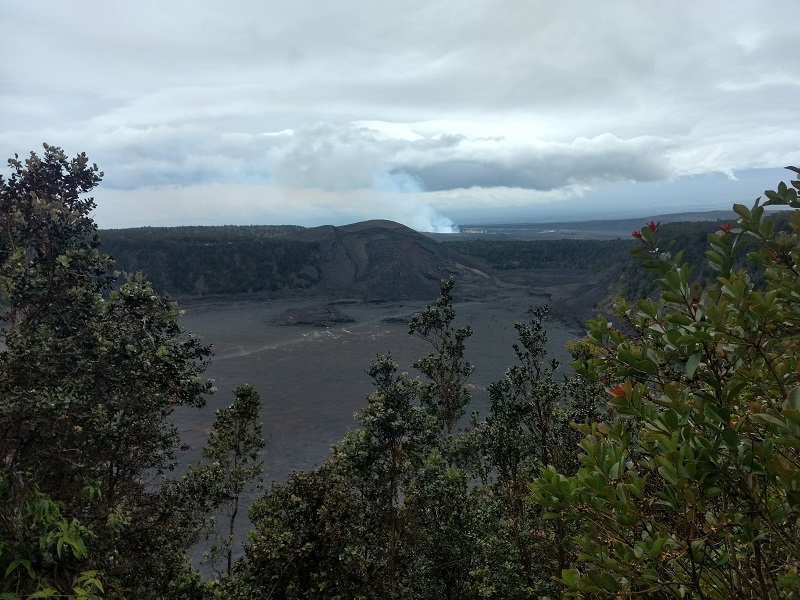Hiking Kilauea Iki to Thurston Lava Tube Trail
Kilauea Iki to Thurston Lava Tube Trail is a heavily trafficked loop trail with in Hawai’i Volcanoes National Park. This trail is unique because of the way the trail takes hikers through the crater floor of an active volcano. While the last time Kilauea Iki erupted was in 1959, evidence of lava beneath the surface is still evident. As rain water falls through the cracks in rocks, steam coming through the ground is visible throughout the crater. The hike is also unique in that the trail takes hikers through where lava cut paths straight through dense patches of thick tropical jungle.
On A Personal Note:
Kilauea Iki can be done as a stand alone hike without doing the Thurston Lava Tube but the trail ends right where the lava tube trail begins. The lava trail is quite easy about about one mile in length. The trail takes you through a lit up lava tube that was carved out of rocks. This tube is an iconic part of the park and a must do. Each trail can be done as individual hikes or together as one loop.
Looking for another trail nearby? Check out the Keanakako’i Crater and Lava Tree hike. This short trail takes visitors to the edge of a large crater. The hike also includes an older lava floor that destroyed an old forest. What’s left in the wake of the flows destruction are pillars of lava trees several feet in height.
Do you have any updates to the hiking trail or want to share your hike/pictures? Please leave a comment below.
- Overall Difficulty 30%
- Overall Views: 90%
Kilauea Iki To Thurston Lava Tube Quick Facts:
Directions:
Kilauea Iki Trail To Thurston Lava Tube Pictures:
- The view of Kilauea Iki crater from the dense jungle rim.
- The smoking view of Halema’uma’u Crater from Kilauea Iki
- The view of Kilauea Iki vent and the cinder cone built up behind it from it’s last eruption.
- Along the crater rim, the trail is mostly dense tropical forest.
- The trail opens up from forest to lava plains.
- The crater floor.
- Kilauea Iki vent.
- Kilauea Iki vent.
- Thurston Lava Tub trail head.
Who Kilauea Iki Trail To Thurston Lava Tube Trail Is For:
Advanced Hikers: This is a perfect hike with incredible views.
Expert Hikers: This is is a perfect hike with incredible views.
It’s always a good idea to be aware of what type of hiking level you’re at.
Best Time Of Year To Kilauea Iki and Thurston Lava Tube:
Kilauea Iki and Thurston Lava Tube Trail Conditions:
Once the trail winds down the crater wall, the path opens up into the crater floor. On the crater floor you’ll have views of the vent where the lava came out of, steam coming out of rocks, and the surrounding forest/cliffs. The jungle part of the trail is not exposed to sun and the forest canopy collects most of the rain. However, the crater floor is completely open to the elements and you can get quite wet if it’s raining. If the sun is out, the black lava can push the temperature to around 100 degrees. The trail on the crater floor is for the most part defined. Look for stacked rocks on among the lava to guide your way. The trail is heavily populated so you shouldn’t have any issue finding your way around.
As the trail winds through the crater and back up the crater walls it ends at the Thurston Lava Tube Trail. Here there are two options: to continue the loop trail about another half mile to complete the Kilauea Iki loop trail or stop to see the lava tube. Thurston’s lava tube is about a mile in length down a small decline and back up a small incline. The trail takes you through a popular lava tube. I think it’s worth it to just do both if you’re able to. The lava tube trail is mostly a paved incline/decline with a handrail. The actual lava tube portion is damp and humid from rain water that has dripped through cracks in the porous rocks. The inside of the tube is lit by a lighting system placed by the park service. Once back up the trail, continue back on the Kilauea Iki Crater Trail for about half a mile to the parking lot.
The trail weather conditions can always be changing. The elevation is high and mornings can be cool with temperatures in the 50’s in the shaded forest. However, the crater floor can be quite hot in the direct sun as I mentioned. Rain can also be common. Hiking layers are recommended. One to two liters of water should be fine as well as a small snack if you think you’d need it.
















